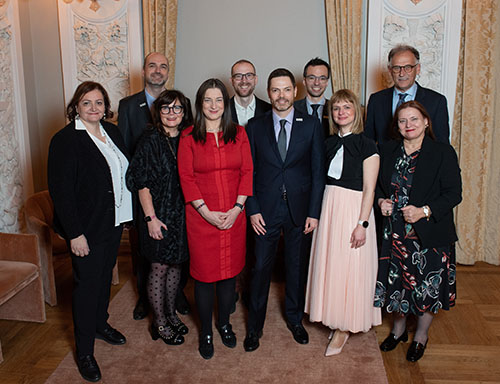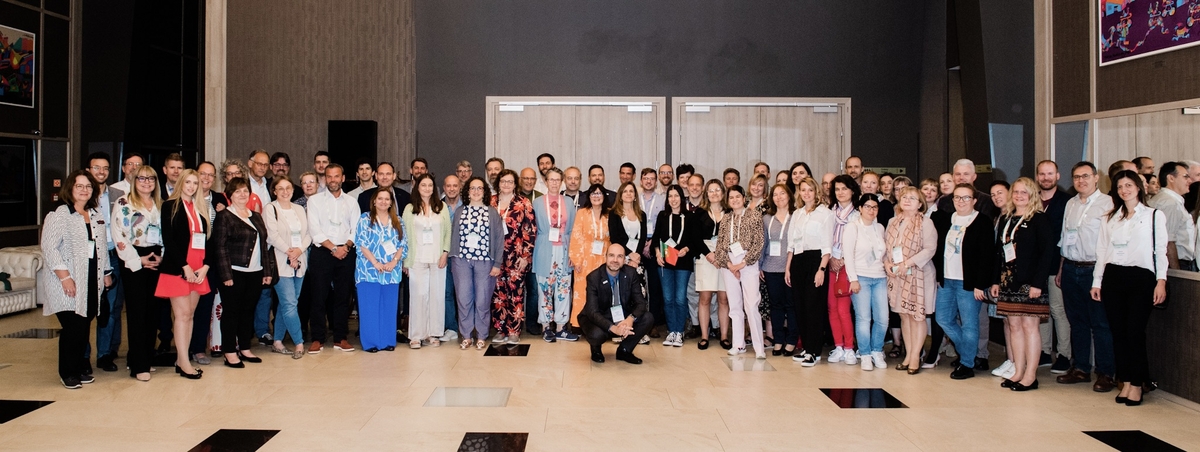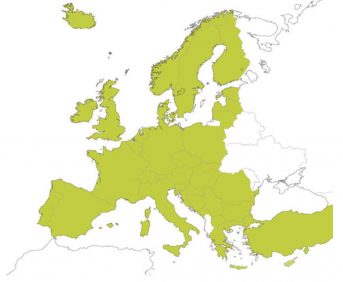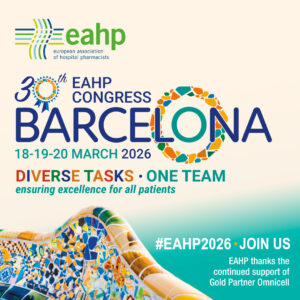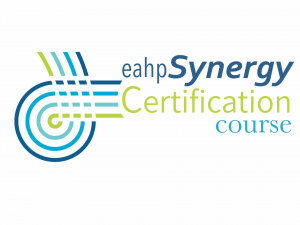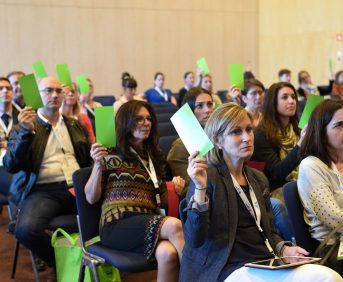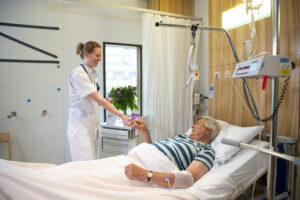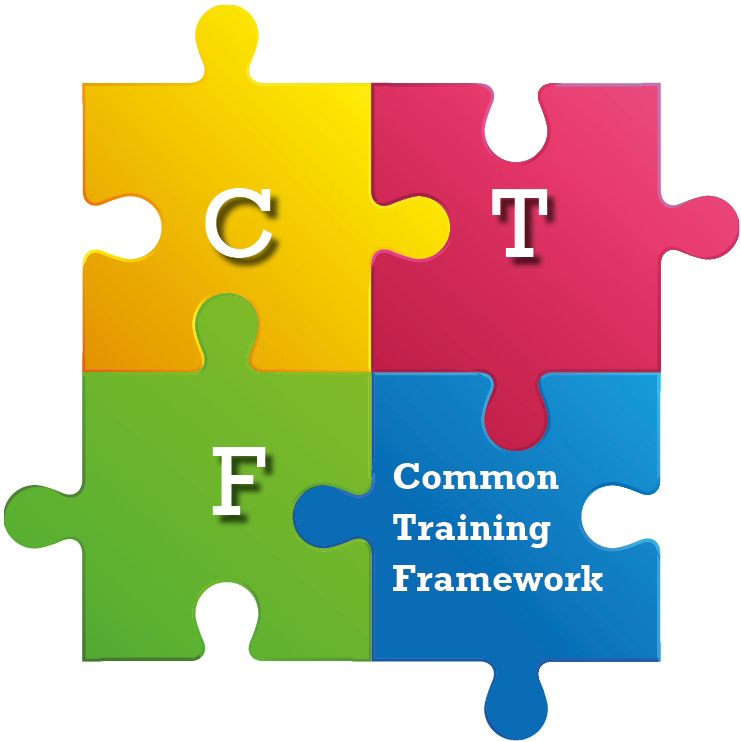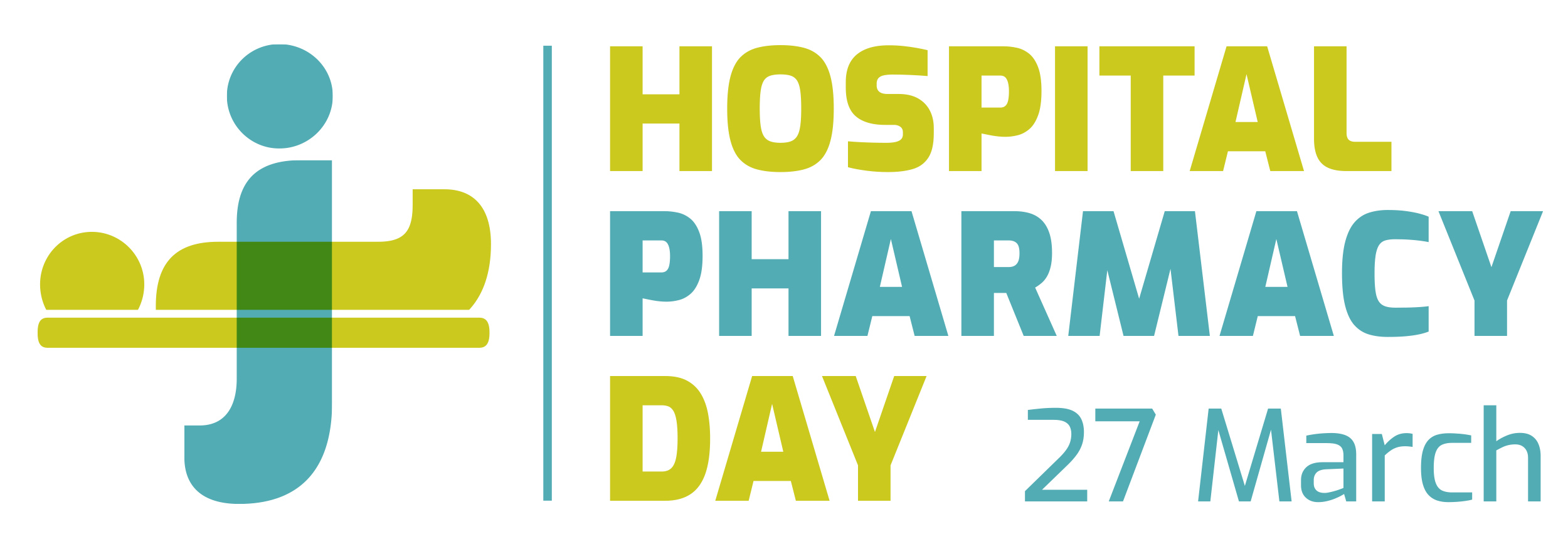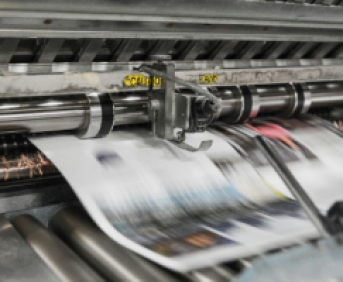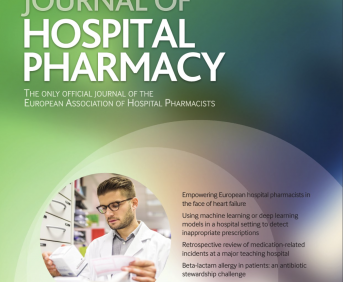IatroMed 360°#Neonat: methodology to develop and evaluate a virtual reality-training course on medication error prevention and management in neonatal intensive care units (NICUs)
Pdf

European Statement
Patient Safety and Quality Assurance
Author(s)
Elodie Delavoipière, Laura Fazilleau, Carine Lehoussel, Isabelle Goyer, François-Xavier Roth, Julien Mourdie, Agnès Bobay-Madic, Simon Rodier, Bernard Guillois, Albane Cherel
Why was it done?
360° virtual room of errors is an innovative educational tool which can be included in strategies of ME risk management. NICUs are high-risk areas and consequently, a priority target. Therefore, we developed and evaluated a virtual reality-training program based on medication error management in the NICU of a university hospital centre.
What was done?
A virtual reality-training course was developed and evaluated, regarding prevention and management of medication errors (ME) in NICUs.
How was it done?
A multidisciplinary working group was set up (2 pharmacists, 2 neonatologists, 1 pharmacy resident and 3 NICU nurses) to define: the target audience, the training model, the assessment methods (pre-training and post-training evaluations), training days and educational materials.
What has been achieved?
The program was intended for professionals involved in the medication circuit in the NICU: physicians, residents, and nurses. Weekly sessions have been scheduled in order to train 99 professionals. Every session was run by 3 professionals (physician, nurse and pharmacist) and lasted two hours and a half. The session was divided into 5 stages: 1/pre-training evaluation, 2/briefing, 3/360° digital simulation allowing ME detection, 4/debriefing, 5/ post-training evaluation. Although, it was a digital-training, a pedagogical formula with “classroom” training sessions has been chosen in order to promote interactivity between learners and trainers particularly during the debriefing. This virtual reality-training course was assessed by Kirkpatrick’s four levels of training evaluation model: satisfaction questionnaires, knowledge evaluation and skills self-assessment, audits of practices, monitoring of indicators (adverse event reports). Assessments were done before each session, immediately after and within 3 months of the session, to both evaluate and enhance educational impact.
What next?
This concept promotes the link between clinicians from the NICU and the multi-disciplinary approach concerning the risk management of ME. By directly involving all the healthcare professionals, this innovative training provides a patient-safety culture development and the implementation of safety measures. The implementation of this training concept in a multi-centric assessment of professional practices should enable to confirm pedagogical interest of such innovative sessions and his deployment in other health facilities.
PHARMACOGENETICS IS GROWING FAST
Pdf

European Statement
Clinical Pharmacy Services
Author(s)
Xando Díaz-Villamarín, Ana Pozo-Agundo, Paloma García-Navas, Celia Castaño-Amores, Alba Antunez-Rodriguez, Cristina Lucía Dávila-Fajardo
Why was it done?
Pharmacogenetics (PGx) has the potential to predict patient´s drug response. Many genetic polymorphisms have been associated with variable drug response. This has been demonstrated with the highest level of evidence in fact many of them have been included in clinical dosing guidelines such as those from the Dutch Pharmacogenomics Working Group (DPWG) and Clinical Pharmacogenetics Implementation Consortium (CPIC). Actually, many drug labels include the recommendation about genotyping specific single nucleotide polymorphisms (SNP) prior to drug prescription.
What was done?
We have implemented pharmacogenetic tests in our hospital for a total of nine drugs.
How was it done?
Our hospital provides a PGx test service according to the following workflow. Physicians order the PGx test to the Pharmacy Unit, we take a saliva sample with sterile-cotton tipped swabs and send them to the Genomic Unit at Genyo. There, we extract the DNA and genotype the variants of interest. Genetic results are reported back to the Pharmacy Unit within 48-72 hours. After genotype-phenotype-recommendation translation according to the CPIC and DPWG dosing guidelines, we upload the dosing recommendation as a PGx report to the electronic patient´s medical history.
What has been achieved?
Since 2012, 2414 patients have benefited from our PGx test service for at least one drug-gene interaction. These tests have been requested by seven hospital departments with regard to a total of nine different drugs. We have reported 932 PGx dosing recommendations: Clopidogrel with 2013 genotyped patients and 845 dosing recommendations; Azathioprine with 208 and 21; Capecitabine: 48 and 1; 5-FU: 5 patients without recommendations; Tamoxifen: 117 and 48; Trastuzumab: 34 and 15; Irinotecan: 4 and 2; Simvastatin/Atorvastatin: 2 genotyped patients and no recommendations.
What next?
Since the first PGx test in 2012, we have been able to implement PGx tests in daily clinical routine in our hospital affecting 9 drugs. 2414 patients have benefited from this service and we are working on the implementation of new polymorphisms affecting drug response to expand our services.
Role of pharmacists during COVID-19 pandemic in a Belgian general hospital
Pdf

European Statement
Patient Safety and Quality Assurance
Author(s)
Lotte Deschepper, Kenny Noerens, Nilgün Kizilmese
Why was it done?
The COVID-19 pandemic caused limited availability of critical drugs and rapidly evolving treatment guidelines. Patient safety must be guaranteed at all times. However, the pandemic took the follow-up of drug shortages to an unprecedented level, increasing the risk of errors. Fulfilling this task was therefore difficult and new strategies needed to be implemented.
What was done?
In our hospital one pharmacist was dedicated fulltime to the COVID-19 drug management. Another pharmacist was committed to ensure the safe and efficacious use of drugs by conducting medication reviews and giving relevant drug and laboratory recommendations.
How was it done?
Microsoft Power BI ©, a tool to analyze data, was used to monitor the specific drug needs on the COVID-wards. Higher drug consumption was more rapidly detected and more specific actions could be executed. The available stocks in the hospital were also registered in a database and this information was updated and reported daily to the medical staff. In this way treatment guidelines could be proactively adjusted if necessary. Medication alerts were sent regularly by mail to ensure that all health care providers were informed about (temporary) changes in order to reduce the risk of medication errors.
Additionally, pharmacists collected evidence‐based drug information concerning indications, dosing, possible side effects, drug‐drug interactions and other precautions based on (inter)national guidelines. This information was used to develop a back-office validation tool that supported pharmacists to conduct medication reviews in a uniform manner. Daily updated reports from Microsoft Power BI © were used to analyze relevant interactions and contra-indications. Pharmaceutical recommendations were promptly documented and reported in the medical record of the patient and the physician was contacted immediately if urgent.
What has been achieved?
Due to the multi-disciplinary approach and guided medication use, therapy continuation could be guaranteed for all patients. Our validation tool resulted in the early detection and interception of medication errors ensuring patient safety.
What next?
A retrospective risk assessment will be done to evaluate our approach and a disaster plan concerning medication will be established based on our experience. The development of a computer-based analytical tool will be encouraged to maximize patient safety while minimizing risk of medication errors.
A PROTOCOL FOR PLACEMENT AND REMOVAL OF PERSONAL PROTECTIVE EQUIPMENT IN A POSSIBLE CASE OF CORONAVIRUS SARS-CoV-2
Pdf

European Statement
Selection, Procurement and Distribution
Author(s)
Rebeca Iglesias-Barreira, Emilio Rubén Pego-Pérez, Carlos Sandoval-Aquino, Cristina López-Pardo y Pardo, Maria Jesús Rodríguez-Gay
Why was it done?
To guarantee workers safety as well as optimize the use of PPE in the hospital.
What was done?
To develop a protocol for placement and removal of personal protective equipment (PPE), established for contact with possible or confirmed coronavirus SARS-CoV-2 infected patients, taking into account the medical devices (MD) available during the pandemic. Alternatives and strategies were also proposed for resources optimization. Final protocol resulted from a multidisciplinary team work (Hospital Pharmacy Service team and Emergency Service workers). It was finally revised and approved by the Medical and Quality Direction.
How was it done?
1)A systematic bibliographic review was made, for articles selection on the placement / removal of PPE. Technical specifications of the available MD and the sanitary recommendations of the competent organitations were reviewed.
2)Establishment of PPE components, and the order of placement and removal:
a. PPE placement:1-Wash hands (WH).2-Place shims.3-WH.4-Put on the first pair of gloves.5-Put on FFP2 mask.6-Wear waterproof protective overalls from the feet.7-Place garbage bags on feet and adjust them on legs.8-Wash gloves with a hydroalcoholic solution (HS).9-Put on second pair of gloves.10-Put on a standard/reinforced surgical gown.11-Wash HS.12-Put on surgical mask.13-Put on disposable gown.14-Put on third pair of gloves.15-Put on face protection screen. 16-Put on surgical cap and fit it over a face shield.
b. PPE removal: a) Before leaving the isolation room: 1-Remove and discard bags from both feet.2-Remove and discard disposable gown.3-Remove and discard the outermost gloves. b) Outside the isolation room: 1-Wash HS.2-Remove surgical cap and screen (reserve screen).3-Remove and discard surgical mask.4-Wash HS.5-Remove the standard/reinforced surgical gown and reserve it.6-Remove second pair of gloves.7-Wash HS.c) Before entering the clean area:1-Remove shoes.2-Remove third pair of gloves.d)Go to the clean area:1-Disinfect footwear.2-Wash HS.3-Remove monkey and if necessary reserve it. 4-Wash HS.5-Remove FFP2 mask and reserve it if necessary.6-WH.
c. A team member read and check all steps carried out during the all steps procedure.
What has been achieved?
The protocol was followed by 54 (100%) workers. Since its implantation, on March 16 th, only the 3,7% (n=2) of workers were infected by SARS-CoV-2.
What next?
The protocol is under constant revision and modification to adapt it to the available MD in every moment.
THE APPLICATION OF AN EHEALTH MODEL IN THE HEALTH CARE SYSTEM
Pdf

European Statement
Clinical Pharmacy Services
Author(s)
MAR GOMIS-PASTOR, ANNA DE DIOS LÓPEZ, MARIA ANTONIA MANGUES, MIRIAM ORS, MERITXELL CUCALA, CATERINA SANPOL, VICTOR ROBERT, XAVIER BORRAS, GEMMA CRAYWINCKEL
Why was it done?
HTP are therapeutically complex patients who may benefit from an intensive telematic follow-up. Moreover, human relations among patients and health providers may be enhanced to improve patients’ empowerment with their health care. Additionally, interdisciplinary eHealth projects lead to increased interaction among health providers, expanding advanced patient-centered care in healthcare systems.
What was done?
An eHealth program directed to heart transplant patients (HTP) was implemented. The software developed was called mHeart and consists on a mobile phone application complemented by a website(https://n9.cl/ajut). A pilot study to validate the software and a clinical trial were conducted. This tool is now extended into clinical practice.
How was it done?
This project and its potential scalability has achieved the creation of a well-established framework involving among relevant others the Legal Department, the Information Systems Department, the patient data protection supervisor, and the Innovation Research Institute.
The success and the scalability of these innovative projects in our centre depended on health providers’ engagement with eHealth, new interoperability solutions, adequate institutional support, and government reimbursement models.
What has been achieved?
The clinical trial conducted in 134HTP has demonstrated to improve recipients’ adherence to immunosuppressants (85% mHeart follow-up vs 46% conventional follow-up)[OR=6.7 (2.9;15.8),P-value=.000], to improve patients’ experience of therapeutic regimens and to reduce in-clinic facilities because the mHeart follow-up. (65% mHeart follow-up vs 35% conventional follow-up)[OR=3.4 (1.7;6.9),P-value=.001].
What next?
This eHealth experience has allowed continuing creating evidence on the use of the eHealth in other populations: an onco-hematological platform, EMMA(Ehealth Medical self-Management Aid), has been designed including diverse profiles depending on the clinical specifications (e.g. multiple myeloma or bone marrow transplant conditions); MyPlan has been adapted to perform an interdisciplinary follow-up of any multimorbid population with polypharmacy. Thus, the system can be used in any multimorbid patients by activating or omitting certain modules that define the target patients’ specific comorbidities (e.g. glycemia module or blood pressure module).
The new EMMA and MyPlan will be clinically tested in diverse trials in 2020 including several health care interdisciplinary teams, including the emergency setting, onco-hematology, migraine, dyslipidemia and cardiovascular risk, among relevant others. In addition, other Spanish centers are implementing the eHealth model and the software in their Institutions assisted by the experience gathered.
Implementation of pharmacological consultation as part of geriatric trauma treatment
Pdf

European Statement
Introductory Statements and Governance
Author(s)
Tanja Schicksnus
Why was it done?
The team of the geriatric trauma center consists of an orthopedic surgeon, geriatrician, nurse, physiotherapist, occupational therapist and a discharge management and diabetic nutrition expert according to the German society for orthopedic surgery (DGU) and now also a pharmacist who performs risk screening for drug-related problems such as fall, dizziness, cognitive impairment, conspicuous laboratory values, lack of appetite, etc. immediately after admission, in order to optimize drug therapy.
What was done?
The geriatric trauma center aims to provide geriatric patients with the best possible peri- and post-operative care after a fall with a fracture so that they resume their usual life and environment after the hospital stay. The pharmacist joined the interdisciplinary team with the aim of a medication review for the often multi-morbid and multi-prescription patients.
How was it done?
After the patient has been assigned to geriatric complex therapy according to the DGU criteria, the doctor requests a pharmacological consultation for this patient via the digital patient record. The pharmacist carries out a medication analysis with information from the record as well as bed side visits focusing on possible medication based problems.
Results are stored in the consultation report, serving as documentation and as basis for later evaluation. Important information for immediate implementation is highlighted in the digital file and transmitted to the attending physician by telephone.
Once a week, the entire team meets, with the scope for each patient being: What are the remaining problems? How can these be solved (interdisciplinary)?
What has been achieved?
During four months, medication reviews were carried out for about 100 patients. In the areas of bleeding risk, anticholinergic adverse events, antibiotics, malnutrition, dose adjustments and medicines inappropriate for geriatric patients, for one third of patients corrections led to an improvement in patients. For nearly 10% of patients also a prescription cascade was resolved and some medical device training has increased drug therapy safety.
What next?
Future benefit evaluation will be carried out based on resumption of patients due to a fall, in the categories: Time until next hospital admission, reason for next admission, adoption of optimized medication plan.
DELIVERY OF SPECIALISED MEDICINES IN MEDICINE POST BOXES – A PILOT STUDY
Pdf

European Statement
Clinical Pharmacy Services
Author(s)
Maja Kirstine Brøns, Gitte Borup
Why was it done?
The purpose was to move medicine collection from the outpatient clinics to a MPB in order to reduce CO2-emission, due to less kilometers traveled by patients, to increase equal access to healthcare services, and to reduce physical patient contact during a global pandemic.
What was done?
This was a pilot study that investigated a method for, and patient satisfaction with, delivery of specialized cost-free hospital medicines via Medicine Post Boxes (MPB) in rural areas.
How was it done?
The project was initiated by clinical pharmacists, who acted as interdisciplinary liaisons, who understood the clinical aspect of the medical treatment, the importance of good distribution practice and the logistic capacity at the hospital pharmacy. Having completed clinical controls via telephone, the clinic forwarded the information needed to the hospital pharmacy. Initially, all requisition forms were checked by clinical pharmacists to ensure complete information was given, and that documentation was performed properly. Once fully implemented, a task shifting onto pharmaconomist was done concerning the control of the requisitions, however initiation of cooperation and problem solving with the clinic was maintained as a pharmacist task.
What has been achieved?
Focus group interviews with doctors and nurses from the clinics expressed satisfaction with the flexibility of conducting clinical controls over the phone, and not having to handle the practical part of ordering, documenting and handing out medicines. No concerns of patient safety were expressed, and a wish for full coverage for medicine delivery via MPB was stated. A survey among the patients using the MPB was conducted: A total of 148 respondent participated of whom 98 % stated being ’very pleased’ or ’pleased’ with the service. Also, 98 % felt safe to ’a very high degree’ or ’high degree’ with using the MPB and 99 % wished to use the MPB again. Estimates of CO2 reduction have not yet been calculated.
What next?
MPB’s should be available in urban areas also, as it increases flexibility for the patients and healthcare professionals. The goal is to include all suitable clinics and patients who receive long term treatment with hospital medicines
PANDEMIC CRISIS COVID 19: THE DRUGS HOME DELIVERY AS A TOOL FOR ADHERENCE AND COMPLIANCE
European Statement
Clinical Pharmacy Services
Author(s)
BARBARA RE, MARTA DEL VECCHIO, CLAUDIA LAURIA PANTANO, ELIROSA MINNITI , VITO LADISA
Why was it done?
The covid-19 pandemic and the lockdown made it difficult and very often not possible to access hospital pharmacies for dispensing of drugs for cancer treatment
What was done?
Drugs homedelivery has been implemented for fragile patients and at risk both oncological and hemato-oncological, all over the italian territory
How was it done?
Through the telemedicine program, in agreement with the oncologist, patients unable to reach the pathology doctor’s office are contacted and the project explained to them. If the patient accepts the delivery at home, paths with specialized couriers have been activated, in compliance with the GDPR, which ensure the delivery of medicines within 48 hours. Upon delivery The Pharmacist contacts the patient to ensure that they have been received the medicines and reinforces how you take the drug and the potential side effects that need to be reported to doctor and / or pharmacist
What has been achieved?
In the period from March to September 2020, 501 deliveries were made, of which 301 in the regional territory and 200 in the national territory. 423 patients were contacted, A Customer Satisfaction was activated to which 90% of patients with a high degree of acceptance of the service responded
What next?
The Homedelivery service has shown that integrating telemedicine, with the collaboration oncologist and pharmacist, allows, when possible, to avoid fragile patients having to go to the hospital every month to collect the drug needed for their treatment. Furthermore, the role of the pharmacist will be increasingly central in the home clinical management of this patient population to assure Adherence and Compliance even in at Home setting.
DEFINING DOSAGE REGIMENS OF ERLOTINIB AND GEFITINIB IN NON-SMALL CELL LUNG CANCER PATIENTS USING MODELLING AND SIMULATION (submitted in 2019)
Pdf

European Statement
Clinical Pharmacy Services
Author(s)
SOFIA KONSTANTINIDOU, VANGELIS KARALIS
Why was it done?
Tyrosine kinase inhibitors (TKIs), like erlotinib and gefitinib, are widely used in anticancer therapy. However, after long term administration of TKIs, resistance is observed in the majority of patients. Thus, it is necessary to be able to define individualised dosage regimens for TKIs in cancer patients. Nowadays, modelling and simulation approaches represent the most powerful tool in the hands of clinical pharmacists towards precision medicine.
What was done?
Population pharmacokinetic (PK) – pharmacodynamic (PD) modelling was utilised to simulate erlotinib and gefitinib dosage regimens for non-small cell lung cancer. In silico clinical trials with virtual patients, of several resistance levels, were simulated in order to optimise pharmacotherapy and get better therapeutic outcomes.
How was it done?
The utilised PK/PD model and average parameter values were obtained from the study of Eigenmann and colleagues. This model was fully validated using statistical criteria and goodness of fit plots. In order to simulate many possible conditions that may occur in clinical practice, several different values of erlotinib and gefitinib clearance, absorption rate, pharmacodynamic characteristics (like tumor volume), and resistance were assessed. In addition, several dosage schemes were simulated. The entire modelling work was performed in Monolix® 2019R1.
What has been achieved?
Concentration vs. time and effect vs. time plots for the virtual patients were simulated for a variety of conditions and tumour resistance levels. For both TKIs, decrease of body clearance led to higher plasma concentrations, as well as more intense and longer duration of the effect (i.e. tumour volume shrinkage). Enhanced drug effect on resistant cells resulted in a decrease in tumour volume. In addition, a variety of concentration-time profiles were simulated, making it possible to choose the best regimen for each patient.
What next?
In this study, the use of modelling techniques led to the simulation of many conditions of patients and adjustment of dosage regimens according to their needs. Wider application of in silico methods using virtual patients will allow the design of the most appropriate individualised dosage schemes tailored to the patients’ requirements.
IMPACT OF PLANTS ON ANTICANCER DRUGS METABOLISM: DEVELOPMENT OF A DATABASE TO FACILITATE THE PHARMACIST’S EXPERTISE (submitted in 2019)
Pdf

European Statement
Clinical Pharmacy Services
Author(s)
ANAIS AMAR, SIMON CLAUTRIER, MORGANE GIOVANELLI, REGINE CHEVRIER
Why was it done?
The phytotherapy market has continued to grow for several years. However, in oncology, concomitant use of plants with oral or injectable chemotherapies can be harmful. Plants can interact with many cytochromes (CYP), impacting on the biotransformation and kinetics of drugs. While grapefruit or St John’s wort are already recognised as interfering with many therapies, the impact of many plants remains unknown for healthcare professionals. Tools exist to evaluate their effects on drug metabolism, but the multiplication of sources delays and complicates the advice of pharmacists.
What was done?
Centralise information on plant metabolism on a single support by creating a database. Facilitate pharmacist’s expertise about interactions between plants and anticancer drugs.
How was it done?
To create the database, it was necessary to establish an exhaustive list of plants. Three sources of information have been used:
– Inventory of phytotherapy products marketed in 4 drugstores
– Census of plants consumed by patients seen in pharmaceutical consultation (PC)
– Consultation of websites specialized in phytotherapy
Then, an Excel table has been developed:
– each line corresponds to a plant
– each column corresponds respectively to 17 CYP, a transport protein (Pgp), estrogen-like (EL) and antioxidant (AO) properties of the plant.
A colour code has been defined according to the inhibitory (yellow), inductive (blue), EL (purple) and AO (red) action of the plant. If there is no interaction, the box remains blank.
Plant effects data were collected from Hedrine®, Oncolien®, MSKCC, RX list and Drugs.com websites.
What has been achieved?
Finally, 174 plants have been accounted in drugstores, 82 were identified during PC and 129 found on websites. If 10% of plants have an EL action and 16% an AO effect, approximately 30% have inductive and/or inhibitory action of at least one CYP and/or PgP. Since the tool’s creation: 91% of answers could be given immediately to patients compared to only 9% delayed (plants still unreferenced).
What next?
This database is an essential tool for answering questions from patients with anticancer drugs. It saves precious time and responsiveness during PC, but also during patient phone calls. However, critical work with divergent information between sources is to be expected. Currently, as a precaution, we don’t recommend the use of plants subject to such a contradiction.
